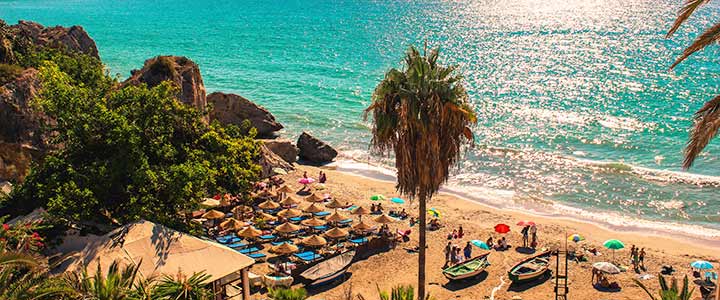Costa del Sol and Malaga Province: A Historic Record of 14 Million Overnight Stays in the First Six Months of the Year
The increase is 1.1 million more than the same period last year, mainly driven by the rise in international tourists.
As we reach the height of summer, many tourism experts and analysts are commenting on the excellent performance of tourism on Costa del Sol in the first half of the year, despite concerns about a decline in the number of Spanish tourists choosing to spend their vacation in the south.
Recent data from Spain’s National Institute of Statistics (INE), published on Thursday, confirm this unprecedented performance up until June. The tourism report, compiled monthly by Turismo Costa del Sol based on INE data, shows that, for the first time, all types of tourist accommodation—except for vacation rental properties, which are still not included in these monthly analyses—surpassed the threshold of 14 million overnight stays in the first six months of the year.
This figure means that Costa del Sol, as a key destination, recorded 1.1 million more overnight stays during the January-June period compared to the same period last year, representing an increase of 9%. This occurred despite the fact that this period includes the weakest months for tourism—January and February—as well as one of the most unfavorable Easter weeks in history, marked by constant rain and an earlier-than-usual date this year.

Costa del Sol and Malaga Province: A Historic Record of 14 Million Overnight Stays in the First Six Months of the Year
The increase is 1.1 million more than the same period last year, driven mainly by the growth in the number of international tourists.
As we reach the height of summer, many tourism experts and analysts are commenting on the excellent performance of tourism on Costa del Sol in the first half of the year, despite concerns about a decline in the number of Spanish tourists choosing to spend their vacations in the south.
Recent data from Spain’s National Institute of Statistics (INE), published on Thursday, confirm this unprecedented performance until June. The tourism report, compiled monthly by Turismo Costa del Sol based on INE data, shows that, for the first time, all types of tourist accommodation—except for vacation rental properties, which are still not included in these monthly analyses—surpassed the threshold of 14 million overnight stays in the first six months of the year. This figure means that Costa del Sol, as a key destination, recorded 1.1 million more overnight stays during the January-June period compared to the same period last year, representing an increase of 9%. This, despite the fact that this period includes the weakest months for tourism—January and February—as well as one of the most unfavorable Easter weeks in history, marked by constant rain and an earlier-than-usual date this year.
Strong Growth Driven by International Tourists
This significant growth, led by a 13.4% increase in overnight stays by international tourists, indicates that this destination is starting to overcome the challenge of seasonality. More travelers are beginning to enjoy Costa del Sol outside of the summer months, and the improvement of air connections during the low season is beginning to have an impact.
It’s also important to note that these record numbers coincide with a clear drop in domestic tourism to Costa del Sol during the first six months of the year, with a more pronounced decrease in June. In fact, indicators for Spanish tourists and their overnight stays are the only ones that show negative values in the statistics for the first half of the year. Specifically, nearly 2% fewer Spanish tourists arrived, and 4% fewer nights were booked in hotels, rural houses, campsites, and tourist apartments from January to June.
International Tourists Boost Tourism
These figures contrast with the growth seen in international markets, which generated 1.2 million more overnight stays in the first six months compared to the same period last year, which was already the best full year in the history of tourism on Costa del Sol, 2023.
The only type of accommodation that managed to maintain and even slightly increase domestic tourism levels were campsites, which saw a 3.5% increase in the number of overnight stays. These data suggest that pricing may be a key factor causing Spaniards to be more reluctant to book their stays. In this regard, the Turismo Costa del Sol report highlights that hotel rates in June in Malaga province averaged €139.9, compared to €137.4 last year. This represents almost twenty euros more per night than the Andalusian average and 17 euros more than the national average.
13.4% Increase in International Stays
This is the percentage growth of overnight stays by international tourists in the first six months of the year, while Spanish tourists reduced their stays in the destination by 4% during the same period.
On the other hand, away from the coast, the situation is not as favorable, and inland tourist accommodations suffered the most during the first half of the year. By the end of June, they accumulated a 31% drop in arrivals, both domestic and international, with the largest decrease—56%—coming from Spanish visitors.
Job Creation in the Tourism Sector
Among all these data, it is clear that hotels are the driving force behind attracting so many visitors, accounting for ten million of the fourteen million overnight stays recorded during this six-month period. This marked another record by surpassing the ten million overnight stays mark for the first time. These establishments also experienced a decline in domestic tourism, with 3% fewer overnight stays and 1.3% fewer tourists from other parts of Spain. These are the only indicators that appear in red, compared to a three-point increase in the average length of stay, now at 3.28 days, and a rise in average occupancy, which is approaching 60%, up by 2.3%.
This upward trend has also led to more job creation. Specifically, between January and June, hotels needed nearly 900 more workers than in the same period last year. Nearly 14,600 people are currently employed in this sector.
The robust health of tourism on Costa del Sol is also reflected in the creation of 444 new companies and the generation of a total of 8,262 jobs over these six months, an increase of 5.5%.
The Strength of International Tourism Drives Growth on Costa del Sol

In June, just like every other month so far in 2024, international tourism has been the lifeline for the industry. In contrast, while the entire semester saw a decline in the number of Spanish tourists and overnight stays by 1.9% and 4% respectively, the situation worsened in June, marking a cooling to levels not seen before. Although June ended with better results compared to last year, thanks to the influx of foreign tourists, concerns have started to spread within the industry that this cooling may become a trend. The sector suspects that this issue worsened in July, and fears it could have a significant impact in August, the most popular month for Spanish vacations.
This cooling in domestic demand led to nearly 5% fewer Spanish tourists staying in the province’s tourist accommodations in June and a 6.1% drop in overnight stays, which equates to almost 50,000 fewer nights. This decline was compensated by an 8% increase in bookings made by international tourists, who have been following an unstoppable upward trend since the beginning of the year. In fact, 63% of tourists who visited Costa del Sol in June were international, with the majority coming from the United Kingdom, Germany, France, and the Netherlands. Notably, markets such as Italy and Belgium saw increases of over 20%, and arrivals from Poland grew by 50% at the airport. These figures make Costa del Sol the second most popular coastal destination in Spain, after Mallorca.


Join The Discussion